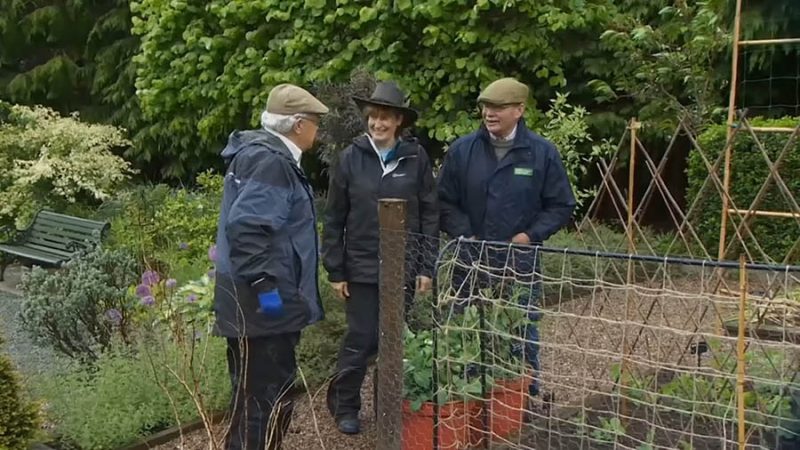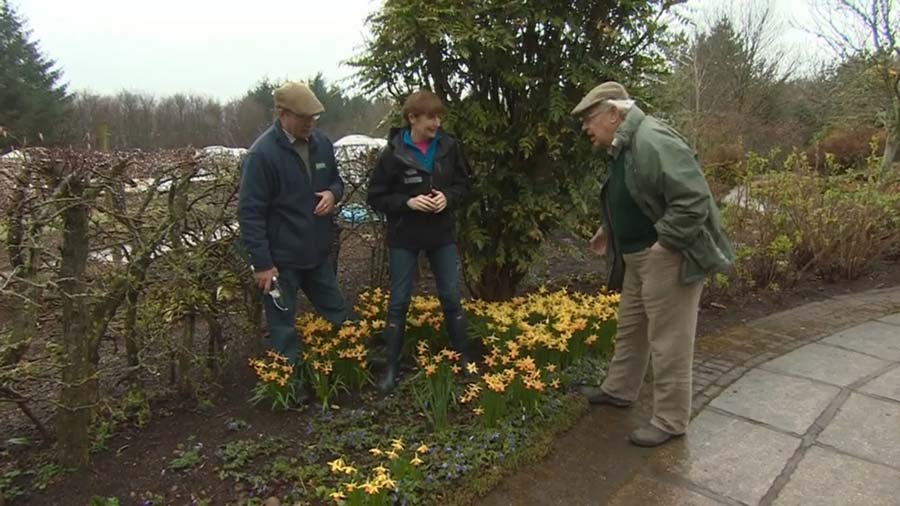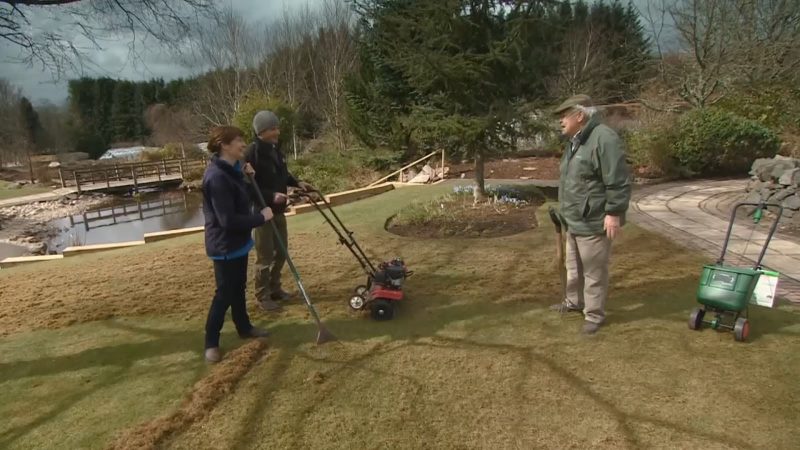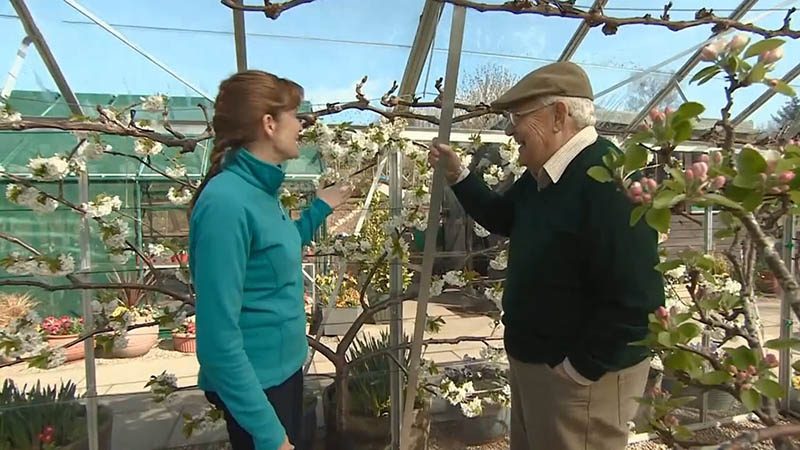Beechgrove Garden episode 1 2016: Beechgrove is back despite winter storms, Jim McColl, Carole Baxter, George Anderson and Chris Beardshaw and the Beechgrove garden are all in one piece, looking radishing and ready to grow. Scotland has suffered the wettest winter on record so Jim and the team wade in to find out how that affects growing conditions.
When Maggie Patience came to live near Aboyne she found winter days short on light and colour. Carole visited Maggie’s garden in early winter to experience the unique way she has added year round colour. Plus Chris literally wades in to Beechgrove’s newly re-vamped pond.
In The Beechgrove Garden episode 1 2016:
Jim, Carole and Chris launched the new seriesfrom a part of Beechgrove that has been cleared ahead of replanting and revamping later in the season as part of our general overhaul of the garden now it’s reached its 20th season. The weather held out for the first full day of filming in the garden and it was definitely a short sleeve
spring weather kind of day.
The winter however has not been so great. Scotland, Wales and North West England have had the wettest winter since records began in 1910. England appeared to have been let off lightly in comparison with the mildest winter on record but Chris commented that although mild, the high winds and storms caused plenty of plant.
damage.
Recap and Review
Chris, Carole and Jim were all in different parts of the garden to review the progress over the winter months. Jim was in the productive part of the garden at the vegetable polytunnels. He was looking at the overwintering crops after the winter. The same crops were grown under cloches outside and in the polytunnel for comparison. The lettuce has already been harvested.
Spring pruning – The Ultimate Guide to Spring Pruning for a Flourishing Garden
Embrace the Season: Spring Pruning for a Healthy Garden
Spring is a time of renewal and regrowth, and one of the most crucial tasks for any gardener is pruning. This essential practice keeps your plants in good health, encourages new growth, and helps maintain a beautiful landscape. In this article, we’ll explore the benefits of spring pruning, best practices, and tips for the most common plants in your garden.
The Importance of Spring Pruning
Pruning is more than just cutting back overgrown branches and leaves. It’s a strategic process that promotes the overall well-being of your plants. When done correctly, spring pruning provides numerous benefits:
- Encourages new growth: Pruning stimulates the plant to produce fresh shoots, branches, and leaves, resulting in a fuller, more robust appearance.
- Improves plant health: Removing dead or diseased branches prevents the spread of infections and infestations, promoting a healthier garden ecosystem.
- Enhances flower and fruit production: By cutting back old growth, you’re allowing energy to be redirected to produce more flowers and fruits.
- Shapes your plants: Pruning helps to maintain a plant’s form and structure, contributing to an aesthetically pleasing landscape.
Pruning Best Practices: Tips and Techniques
To ensure success in your spring pruning endeavors, follow these best practices:
- Use the right tools: Invest in high-quality pruning shears, loppers, and saws. Sharp, clean tools make clean cuts and reduce the risk of infection.
- Time it right: The ideal period for spring pruning is after the last frost but before new growth begins. This timeframe varies depending on your location and specific plant species.
- Know your plants: Understand the growth habits and pruning requirements of the plants in your garden. Some plants benefit from light pruning, while others require more extensive trimming.
- Make proper cuts: Cut at an angle, just above a bud or leaf node, to encourage new growth. Avoid leaving stubs, which can lead to rot or disease.
- Take it slow: Don’t over-prune. Aim to remove no more than 20-30% of a plant’s growth in a single session.
Pruning Guidelines for Common Garden Plants
Now that you’re familiar with the general best practices, let’s dive into specific guidelines for some of the most popular garden plants:
- Deciduous trees and shrubs: For most deciduous trees and shrubs, such as maples, oaks, and lilacs, prune in late winter or early spring when the plant is dormant. Remove dead, diseased, or crossing branches and shape the tree or shrub as desired.
- Evergreens: Prune evergreens like pines, spruces, and firs in late spring or early summer, after new growth has emerged. Lightly trim the new growth to maintain the desired shape.
- Fruit trees: For fruit trees like apples, pears, and cherries, prune in late winter or early spring before buds begin to swell. Remove dead or diseased wood, thin out crowded branches, and encourage fruiting spurs.
- Roses: Spring is the perfect time to prune roses. Cut back dead, diseased, or damaged canes, and trim the remaining healthy canes to a bud that faces outward.
- Perennials: Prune herbaceous perennials like coneflowers, hostas, and daylilies in early spring as new growth emerges. Cut back dead foliage and divide overgrown plants to encourage healthy growth and flowering.
- Vines: For climbing vines like clematis, wisteria, and honeysuckle, spring pruning helps maintain a manageable size and encourages blooming. Prune back dead or weak growth and thin out overcrowded areas, taking care not to over-prune, as this may reduce flowering.
- Ornamental grasses: Prune ornamental grasses such as fountain grass, pampas grass, and feather reed grass in late winter or early spring before new growth starts. Cut back the previous year’s foliage to a few inches above the ground, allowing fresh growth to emerge unobstructed.
By following these guidelines and best practices, you’ll be well on your way to a flourishing garden filled with healthy, vibrant plants. Remember that patience is key when it comes to pruning, and take the time to learn the specific needs of your plants to ensure their optimal growth and beauty.




